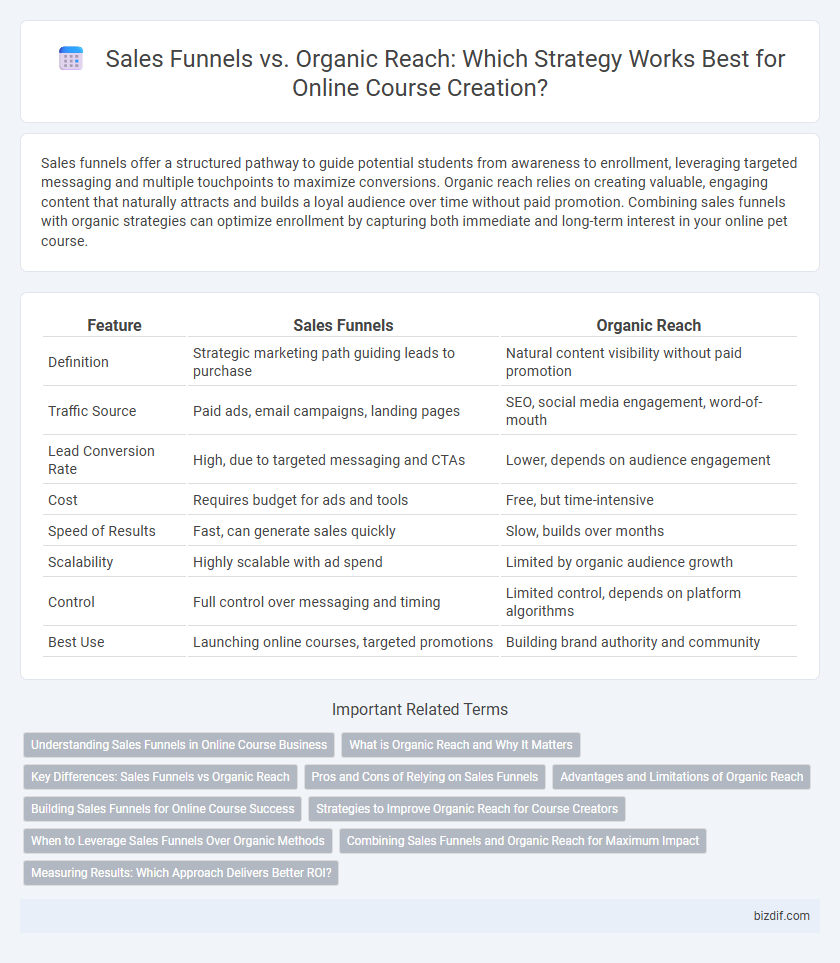Sales funnels offer a structured pathway to guide potential students from awareness to enrollment, leveraging targeted messaging and multiple touchpoints to maximize conversions. Organic reach relies on creating valuable, engaging content that naturally attracts and builds a loyal audience over time without paid promotion. Combining sales funnels with organic strategies can optimize enrollment by capturing both immediate and long-term interest in your online pet course.
Table of Comparison
| Feature | Sales Funnels | Organic Reach |
|---|---|---|
| Definition | Strategic marketing path guiding leads to purchase | Natural content visibility without paid promotion |
| Traffic Source | Paid ads, email campaigns, landing pages | SEO, social media engagement, word-of-mouth |
| Lead Conversion Rate | High, due to targeted messaging and CTAs | Lower, depends on audience engagement |
| Cost | Requires budget for ads and tools | Free, but time-intensive |
| Speed of Results | Fast, can generate sales quickly | Slow, builds over months |
| Scalability | Highly scalable with ad spend | Limited by organic audience growth |
| Control | Full control over messaging and timing | Limited control, depends on platform algorithms |
| Best Use | Launching online courses, targeted promotions | Building brand authority and community |
Understanding Sales Funnels in Online Course Business
Sales funnels in online course business strategically guide potential students from awareness to enrollment, optimizing conversion rates at each stage. Organic reach relies on unpaid methods like SEO and social media content to attract a broad audience but often lacks the targeted progression sales funnels provide. Implementing well-designed sales funnels enhances student acquisition by delivering personalized messaging and timely calls-to-action aligned with user behavior.
What is Organic Reach and Why It Matters
Organic reach refers to the number of people who discover your online course content naturally through unpaid channels like search engines, social media shares, and direct visits. It matters because organic reach builds trust and credibility, attracting engaged learners without the constant cost of paid advertising. Leveraging SEO and valuable content can significantly enhance organic visibility, driving sustainable long-term growth for your course platform.
Key Differences: Sales Funnels vs Organic Reach
Sales funnels in online course creation strategically guide potential students through targeted marketing stages, leveraging email sequences, landing pages, and paid ads to maximize conversions. Organic reach relies on non-paid methods such as SEO, social media engagement, and content marketing to attract and nurture leads more gradually. The key difference lies in the control and predictability of sales funnels compared to the slower, often less predictable growth from organic reach.
Pros and Cons of Relying on Sales Funnels
Relying on sales funnels for online course creation offers predictable revenue streams and targeted customer segmentation but often requires substantial upfront investment in paid advertising and technology. Sales funnels enable precise tracking of conversion metrics, enhancing optimization efforts, yet they can alienate audiences if perceived as overly aggressive or sales-driven. Dependence on sales funnels risks reduced authenticity and long-term brand loyalty, contrasting with the more organic, trust-based growth achieved through content marketing and social engagement.
Advantages and Limitations of Organic Reach
Organic reach in online course creation allows authentic audience engagement without upfront advertising costs, fostering trust and long-term community growth. Limitations include slower audience expansion and reduced visibility due to social media algorithms prioritizing paid content. Effective use of SEO, content quality, and consistent interaction can enhance organic reach but may not achieve rapid scaling like sales funnels.
Building Sales Funnels for Online Course Success
Building sales funnels for online course success drastically improves lead nurturing and conversion rates by guiding potential students through targeted, step-by-step content and offers. Unlike relying solely on organic reach, sales funnels use data-driven strategies such as email sequences, landing pages, and retargeting ads to maximize enrollment and revenue. Effective funnels seamlessly integrate with marketing automation tools, enabling personalized communication that boosts engagement and long-term student retention.
Strategies to Improve Organic Reach for Course Creators
Course creators can enhance organic reach by leveraging content marketing through SEO-optimized blog posts, engaging social media interactions, and video tutorials that address target audience pain points. Consistently publishing valuable, shareable content on platforms like YouTube, Instagram, and LinkedIn boosts visibility and builds trust without relying on paid ads. Developing a community through email newsletters and interactive webinars fosters loyalty and drives organic traffic to course landing pages, creating a sustainable growth strategy.
When to Leverage Sales Funnels Over Organic Methods
Sales funnels are most effective when targeting specific customer segments with tailored messaging and clear conversion paths, ideal for scaling course sales quickly. Organic reach works best for building long-term audience trust and engagement but is slower and less predictable for immediate revenue. Use sales funnels to maximize paid traffic and track ROI during product launches or promotional campaigns.
Combining Sales Funnels and Organic Reach for Maximum Impact
Combining sales funnels and organic reach leverages targeted marketing strategies with authentic audience engagement to maximize online course enrollment. Sales funnels strategically guide prospects through a conversion path using lead magnets, email sequences, and upsells, while organic reach builds trust and credibility through consistent content on social media and SEO. Integrating both approaches enhances visibility, nurtures relationships, and drives higher conversion rates for sustained business growth.
Measuring Results: Which Approach Delivers Better ROI?
Sales funnels provide measurable ROI with clear tracking of conversion rates, customer acquisition costs, and revenue per lead, offering data-driven insights for optimization. Organic reach relies on metrics like engagement, reach growth, and brand awareness, which are less directly tied to sales outcomes but typically incur lower upfront costs. Businesses that prioritize precise ROI measurement often favor sales funnels due to their ability to attribute revenue to specific marketing actions and funnel stages.
Sales funnels vs Organic reach Infographic

 bizdif.com
bizdif.com